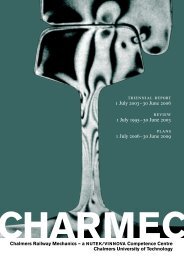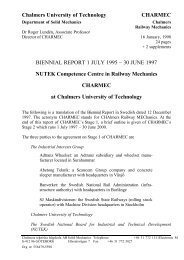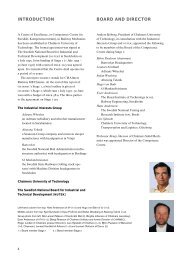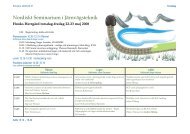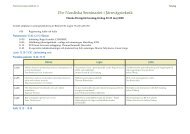You also want an ePaper? Increase the reach of your titles
YUMPU automatically turns print PDFs into web optimized ePapers that Google loves.
SUMMARY OF <strong>CHARMEC</strong> STAGE 3 (cont’d)lence have also been met in qualitative and quantitativeterms. The continued strong support of the participatingindustries is a sign of lively scientific and technical dynamics.Being invited to join industrial/university consortiafor participation at the eu Sixth Framework Programme,attracting new industrial partners, co-operating with eucompanies and being consulted by Deutsche Bahn on the1998 high speed train accident are significant and worthmentioning distinctions.”The staff attached to the Centre, both at Chalmers (23project leaders/principal advisers/senior researchers and24 doctoral candidates) and in the Industrial InterestsGroup (r&d management and experimental staff), havebeen actively involved. Numerous new contacts forco-operation have been established. There have beenfrequent meetings between university researchers andthose working in industry, and these meetings haveresulted both in increased involvement in industrial longtermknowledge development and deeper insights intothe working potential of the university. Mutual learninghas taken place. Two of our new PhDs have been employedby two of charmec’s industrial partners with theremaining four continuing at the University as seniorresearchers in railway mechanics. For concrete resultsachieved in the business activities of the industrial partners,see page 64.Six licentiate’s theses and six doctor’s dissertations inrailway mechanics have been presented by charmec’sresearchers during Stage 3 up to June <strong>2003</strong>. Furthermore,35 articles have been published (or accepted forpublication) in international scientific journals with areferee system, 55 papers have been published in theproceedings of international conferences with a refereesystem, several eu reports have been delivered, 25 researchreports have been edited in our own series ofEnglish-language research publications (without beinginternationally published), 8 master’s theses have beenedited in our own series of student reports (in English),and several other works have been published and presentedat minor seminars etc. For further informationon these publications, see the lists under the projectsdescribed in the next section.As was the case during Stages 1 and 2, four seminarsare usually held during the morning of the same daythat the Board meets in the afternoon. All the charmecBoard members, project leaders, researchers and others(approximately 90 people) are invited to the seminarsand to the lunch that follows. The seminars, at whichall project leaders/supervisors and doctoral candidatespresent and discuss their projects, follow a rolling annualschedule.The continued participation by the charmec researchersin eu projects (Fourth and Fifth Framework Programmes)has expanded collaboration with industries,universities, institutes, administrations and consultanciesall over Europe. charmec’s network linked to the euprojects comprises some 50 organizations in 9 countries;see page 68. We also co-operate with railway institutionsin Australia, Canada, Japan, South Africa and usa.A measure of the scientific standard achieved by theactivities of the University and Industry at ChalmersRailway Mechanics on the international arena is the highlevel of acceptance of articles for journals and of contributionsto conferences. In total, more than 200 sucharticles and contributions have thus far been internationallypublished. A remarkable fact is that no less than20 articles in railway mechanics have now been publishedby the Chalmers/charmec researchers in Proceedings ofthe Institution of Mechanical Engineers, Part f: Journalof Rail and Rapid Transit, which is a leading scientificjournal in the field. A total of 21 licentiate’s degrees and13 doctor’s degrees in railway mechanics have to date(December <strong>2003</strong>) been awarded at Chalmers.charmec runs no special courses, undergraduate orgraduate, in railway mechanics as such. However, a verypositive consequence of charmec’s involvement withindustrial problems has been the exposing and exploitationof several new areas of practical application in thetraditional disciplines and courses at Chalmers (solidmechanics, structural mechanics, engineering metals,concrete structures, machine elements, mechatronics,computer engineering etc). This important impact onthe regular courses raises the motivation of the students.Several undergraduate students have been involved inproject work and/or have written their master’s thesis inrailway mechanics.For special events and achievements during Stage 3,see page 70. It is obvious, in retrospect, that without theframework and support established through the nutek/vinnova Competence Centre concept, the rather smalluniversity/industry collaboration in railway mechanicsalready existing at Chalmers in 1994/95 could not haveexpanded, intramurally and extramurally, nationally andinternationally, as it has now done during charmec’sStages 1, 2 and 3.12



